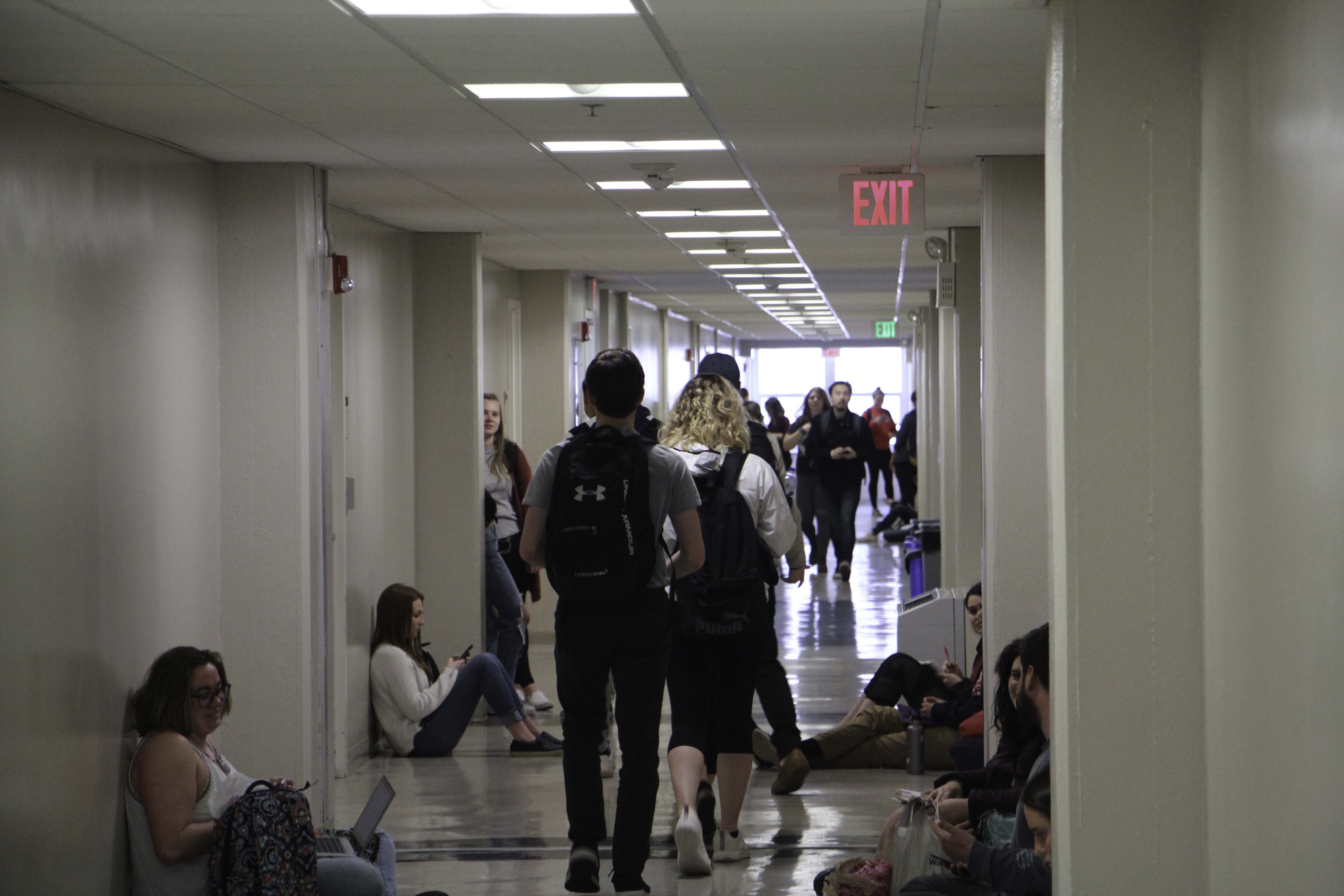Students in Swan Hall sit in the hallway while they wait for classrooms to become available. | Photo by Greg Clark.
The University of Rhode Island has over 16,000 undergraduate and graduate students combined, which can make it difficult to assign classroom space.
“There are 107 that are general assignment classrooms, those are the ones that we control the scheduling for,” said John Humphrey, senior associate director of Enrollment Services. “Then there’s 169 that are departmentally controlled. The departments decide what goes in there… So, 60 percent of the classroom space on campus is controlled by the departments themselves.”
For general assignment classrooms, Enrollment Services uses a database system that assigns classrooms based on size and time. Departments and professors are notified where a section has been scheduled.
However, this process can be difficult due to the limited number of classrooms available during popular teaching times. Enrollment Services tries to encourage departments to spread out their classes by encouraging professors to teach earlier or later in the day, so not as many sections need to be scheduled in the middle of the day.
It is rare that classes will be placed in further away buildings, such as Keaney Gymnasium and Independence Square, unless they are for specific programs such as kinesiology. Professor’s opinions in regards to where classes should be located are also taken into consideration. If a class is full of a majority of athletes, the professor may ask to be placed in Keaney or somewhere close to the athletic centers.
Enrollment Services also accepts room change requests throughout the semester. They often deal with a variety of changes due to a change in professors, accessibility issues, addition of class sections, construction or building emergencies.
“We may have a situation where we scheduled a course in a particular classroom and then there’s a student or faculty member with an accessibility issue that we did not know about when we scheduled the room originally,” said Humphrey. “Then we’ll work with disability services to find a more suitable classroom space.”
The issue of accomodations is a common reason for a room change. If a professor or student has a disability, it is often found out later in the process, possibly even in the middle of a semester.
“An accommodation takes precedence, so those are some of the toughest ones because if you have a student with an accommodation you have to email the department and instructor that we’re moving it,” said Ken Sisson, the assistant director of Enrollment Services. “They might not like where it’s going but we don’t have a choice.”
Building emergencies are another issue that could affect classes unexpectedly during the semester. If a pipe freezes and the room loses heat or has a leak, the class will have to be moved temporarily until repairs are done.
Sometimes Enrollment Services is unable to find a classroom for a change request or new section. Then, the responsibility is relayed back to the departments.
“In a particular instance they came back where they didn’t have a class and that happens,” said Donna Hayden, an administrative assistant to the writing and rhetoric department. “Now and then that happens so you’re like ‘Okay we’re on our own.’ We have to find a classroom. So that puts you in a difficult situation… We work together as best we can, but every now and then you’re thrown a curve and it’s pretty much up to the department to figure it out.”
In that case, the department would first check their own internal classroom schedule. If no classrooms were available they reach out to other departments until a classroom is found.
“In the end it has a positive outcome, but to get to that positive outcome, it’s a scramble and it’s tiring and you shrug your shoulders and question should it be like this, shouldn’t changes be made?” said Hayden.
Sisson, Humphrey and Hayden all agree that the lack of classrooms space can become a large obstacle as the number of students at the University is increasing. Enrollment Services has tried to extend the average day to fit in more classes, but the process is still far from simple.
“We are good at finding solutions, and sometimes it might be that we have to facilitate a discussion with four or five different faculty members to move one class because it’s this domino effect,” said Humphrey. “We try to facilitate that as much as possible so that we get the outcome that we need. It might take a couple of days but at the end of it everyone’s pretty satisfied with the outcome.”

